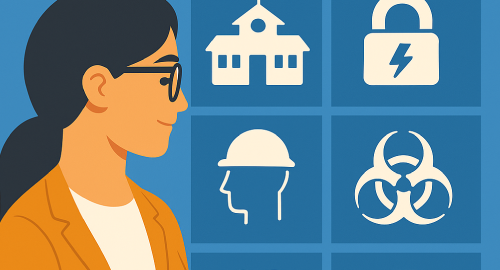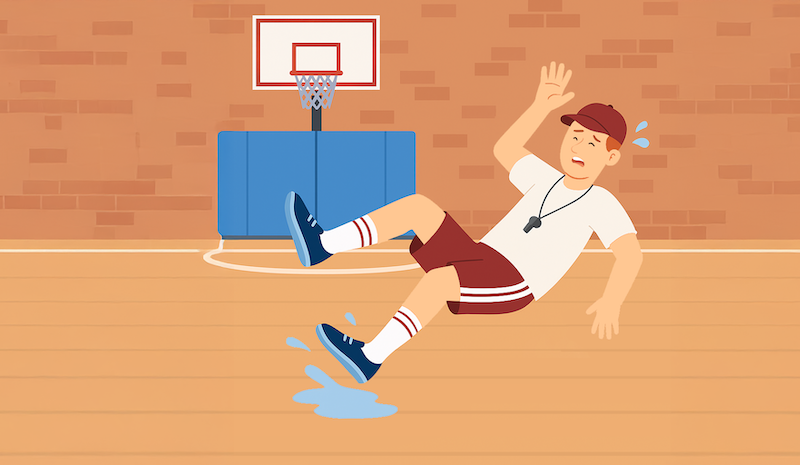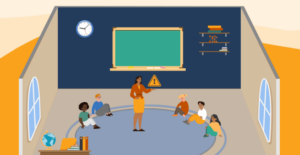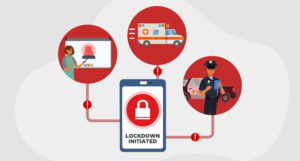Keeping teachers and staff safe ensures every student receives uninterrupted learning. Fewer injuries mean lower workers’ compensation costs, consistent instruction, and stronger morale.
But to build a safer environment, school leaders need more than good intentions—they need visibility into where, how, and why staff are getting hurt. The data reveals clear patterns, and the right strategies can turn insights into prevention.
The Cost of Staff Injuries
Employee injuries drain budgets and disrupt classroom continuity. Workers’ compensation, substitute coverage, and overtime quickly add up. Proactive safety measures protect people first and finances second.
- Workers’ compensation premiums rise after every claim
- Substitute teachers can’t replicate established classroom relationships
- Overtime for maintenance crews strains budgets
According to the U.S. Bureau of Labor Statistics, in 2021–22:
- Teachers had an injury rate of 85.0 cases per 10,000 full-time workers, compared to 180.5 for all occupations
- Falls, slips, and trips were the top cause (31.8 per 10,000)
- Violence and injuries by persons or animals followed closely (20.0 per 10,000)
- Overexertion and bodily reaction ranked third (11.0 per 10,000)
Further, new data from a SFM Mutual Insurance Report shows how and why school staff get injured:
- 40% of claims involve student interaction
- Of those, 64% are caused by students acting out behaviorally
- Other causes include assisting or transferring students (11%), restraint (9%), playing (7%), and breaking up fights (3%)
- Injury types most often reported:
- Fractures and contusions – 59%
- Sprains and strains – 23%
- Punctures and lacerations – 11%
This data shows how important it is to have the right safety protocols and training in place—such as behavior management training, physical safety strategies, and real-time incident reporting.
When schools implement strong safety protocols, the results are clear. One area where this makes a measurable difference is in preventing everyday incidents—like slips, trips, and falls.
Reduce Slips, Trips, and Falls
Districts cut fall‑related injuries when they set clear expectations and equip teams to act.
1. All employees
- Wear task‑appropriate, slip‑resistant footwear
- Route cords away from walkways or cover them securely
- Clean spills and debris immediately
- Use ladders safely; never climb on desks or chairs
2. Facilities teams
- Repair uneven surfaces, torn carpet, and broken stair treads
- Clear ice, snow, and leaves from outdoor paths
- Post “Slippery When Wet” signs when needed
- Replace burnt‑out lights and install handrails where absent
3. Food‑service teams
- Place floor mats at prep and serving lines
- Use edged work surfaces to contain spills
- Ventilate to reduce steam and condensation
4. Transportation staff
- Keep bus steps and aisles clear and dry
- Check handrails daily
- Watch for oil or fluids in garages and lots
5. Fund preventive maintenance
- Budget for timely repairs and safety equipment before costly, reactive repairs after an issue develops
Digital Tools That Keep Staff Safe
Manual tracking lets hazards slip through the cracks. Raptor, powered by PublicSchoolWORKS, offers modules that automate reporting, notifications, and follow‑up so nothing gets missed.
- Hazard & Near‑Miss Reporting – staff submit risks; the system tracks resolution
- Staff Accident Management – automatic First Report of Injury and claim forms
- Staff Compliance Training – assigns, tracks, and refreshes safety courses
Automation delivers accountability without adding paperwork.
Preventing Student Violence: A Three‑Tier Framework
Physical aggression toward staff undermines the learning environment. A layered approach addresses root causes and equips adults to respond.
1. Student Supports
- Tier 1: Teach prosocial skills to every student
- Tier 2: Provide mentoring and targeted support for at‑risk students
- Tier 3: Conduct Functional Behavioral Assessments for chronic cases
2. Staff Training
- Implement evidence‑based classroom management
- Spot early warning signs of aggression
- De‑escalate conflict quickly
- Reinforce the five pillars of social‑emotional learning
- Review the crisis‑response plan every quarter
3. Leadership Oversight
- Stay visible at events and in common areas
- Maintain threat‑assessment and drill schedules
- Analyze behavior and incident data for trends
- Partner with mental‑health providers and law enforcement
- Update safety policies and communication channels annually
Next Steps for Safer Schools
Raptor Technologies streamlines prevention, reporting, and response so educators can focus on teaching—not paperwork.
Ready to lower injuries and costs? Request a personalized demo today.
Related Resources





